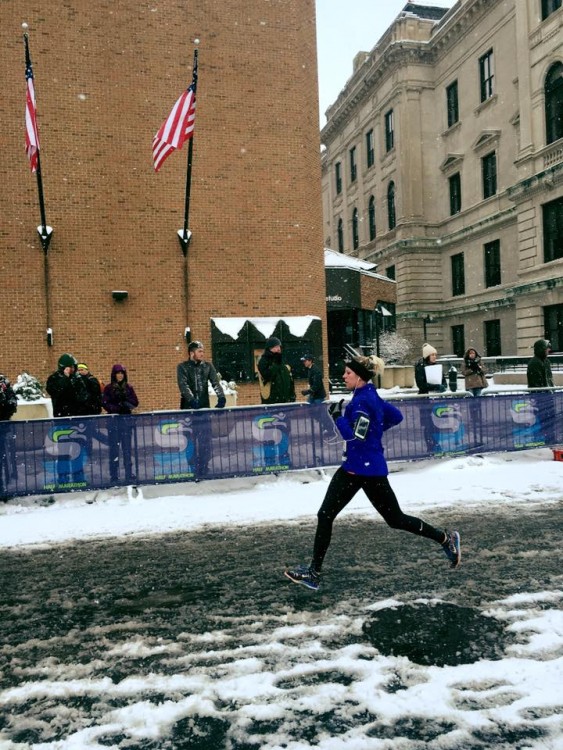
One of the questions I find myself constantly answering is, “Why would you run that far? I’d rather be sleeping!” I’m usually responding to someone who does not understand how much time and effort it takes during marathon training to wake up every Sunday morning and run 12 – 20 miles. Nevertheless, you’re guaranteed at least three 20-mile runs during training to prepare for the big race. The average person cannot comprehend there is so much more to getting up at 6 a.m. and running 20 miles. That average person used to be me, but on November 6th, 2016, I will no longer be a part of that group. I will be a part of the one percent known as “marathon runners.”
My love for running began in the Spring of 2011. I have to say, it was more of a love/hate relationship at first. My fiancé was participating in all of these 5K, 10K, and half marathon races while I was sitting on the sideline as a cheerleader. All I could connect running long distances to was the warm-up run we had to perform before soccer practice in high school. It wasn’t anything I was interested in until he convinced me to sign up for the Mountain Goat Run in Syracuse, NY. This race is 10 miles of rolling hills in Syracuse, and I hated everything about training for it. Flash forward to this spring when I finished the Syracuse Half Marathon in a complete blizzard and told myself I would never, ever run a full marathon.
However, when I took a job as a Special Events Coordinator with the ALS Association Upstate New York Chapter in 2013, I knew I was in for something special. ALS, also known as Lou Gehrig’s Disease or amyotrophic lateral sclerosis, is a progressive neurodegenerative disease that is 100 percent fatal. A few celebrities who have ALS are Stephen Hawking and Steve Gleason. I had the opportunity to plan four walks in the Upstate New York region that would help raise awareness and funds for those living with ALS in 48 counties. Even though I’m not currently working for the ALS Association, I still keep in touch with several families and stay close to what’s going on with research around the disease.
When I left the ALS Association, I found myself working around another rare disease called mesothelioma. Mesothelioma affects thousands of people each year, many of whom may not even know they’re at risk until years later.
This is when it clicked for me. I was meant to help others who are given a dire prognosis and need my help with raising awareness.
It was within this role I was brought to Heather Von St. James, a beautiful mother to Lily, who was diagnosed with mesothelioma when she was 36 years old. To be given a cancer diagnosis where people only live maybe 15 months was something Heather couldn’t accept. As a friend to Heather, it is my duty to help raise awareness surrounding her story in hopes that one day asbestos will be banned in the United States.
When researching opportunities to share Heather’s story in May 2016, I came across the National Organization for Rare Disorders. NORD, an organization that supports every member of the rare disease community with programs and services focused on one ultimate goal: to improve the lives of individuals and families affected by 7,000 rare diseases.
NORD has a Running for Rare team that participates in a number of races throughout the country every year, raising awareness for rare diseases. Again, I felt like this was meant to be an opportunity to combine my passions of raising awareness for rare diseases and running. Not only running a marathon, but running the largest marathon in the world in New York City.
For me, this became so much more than fundraising and representing the rare disease community at a marathon. The Running for Rare team connects you to a patient partner who you run the marathon on behalf of. This year, I am running the New York City Marathon on behalf of Tara Notrica.
Tara has been battling mast cell disease for 10 years. It has completely altered her life. Tara’s health journey began in her early 20s when she would have yearly episodes of facial swelling, hives, vomiting, and constriction of airways. At that time, doctors thought she was having severe allergic reactions and would prescribe over the counter medication. Countless visits to doctors and specialists over the next five years would result in diagnoses of alopecia, lupus, rheumatoid arthritis, Lyme disease, and other autoimmune disorders.
However, as treatments for each of these were unsuccessful, Tara and her family couldn’t help but feel hopeless. Her condition was not improving: She was losing muscle mass, and at one point weighed less than 100 pounds. On April 1, 2011, Tara was finally diagnosed with mast cell activation disorder, a disorder caused by a genetic mutation that results in an excessive number of mast cells in your body. They come from bone marrow and go into all tissues of the body.
Tara had a stem cell transplant using her own cells in July 2015, and unfortunately, it failed. She is back on a targeted form of chemo and is convincing her doctors for a bone marrow transplant. To me, running this marathon isn’t just about the training and miles that go into it. It’s about lives changed, lives touched, and lives improved all because someone cared.
Throughout this summer and while training for this marathon, I have come to realize our lives can simply be the ups and downs of a marathon – but if we give ourselves the time, there are so many amazing things we can experience that cannot be defined by a starting line or a finish line.
We want to hear your story. Become a Mighty contributor here.

